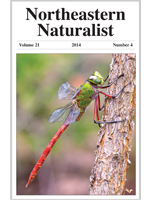The human population and associated watershed development has risen steadily since the 1850s in Rhode Island. With these increases, human-derived wastewater has also risen dramatically, resulting in increasing nitrogen loads to estuarine systems. In this study, we examined relationships of modeled watershed nitrogen loads of 6 coastal subwatersheds of varying land development with the stable nitrogen isotope ratio (δ15N) of salt marsh fish and larvae. There was a significant positive relationship (r = 0.97, P < 0.05) between the watershed modeled percent wastewater and δ15N in Fundulus heteroclitus L. (Common Mummichog), and significantly higher (P < 0.05) δ15N in fish larvae collected from developed mainland marsh sites compared to less-developed island marsh sites. Our results support earlier published findings that fish in coastal marshes are assimilating nitrogen derived from watershed wastewater sources. Furthermore, there was an inverse relationship (P = 0.05) between the modeled percentage of human wastewater and mummichog size. The increasing loads of watershed nitrogen entering into coastal salt marshes are a concern because it is unclear how well salt marsh ecosystems can continue to assimilate high nitrogen inputs especially when also subjected to a warming climate.
How to translate text using browser tools
1 March 2015
Relationships of Modeled Nitrogen Loads with Marsh Fish in the Narragansett Bay Estuary, Rhode Island
Cathleen Wigand,
Heather Smith,
Cassius Spears,
Brandon Keith,
Richard McKinney,
Marnita Chintala,
Kenneth Raposa
ACCESS THE FULL ARTICLE

Northeastern Naturalist
Vol. 22 • No. 1
March 2015
Vol. 22 • No. 1
March 2015




